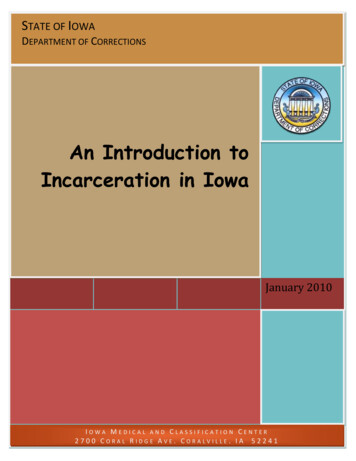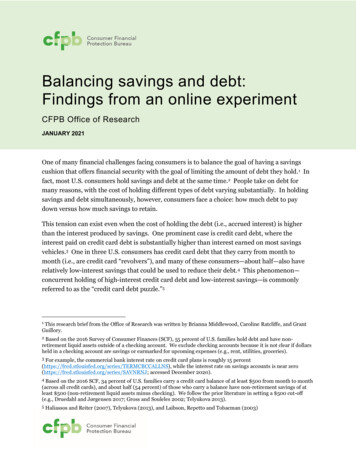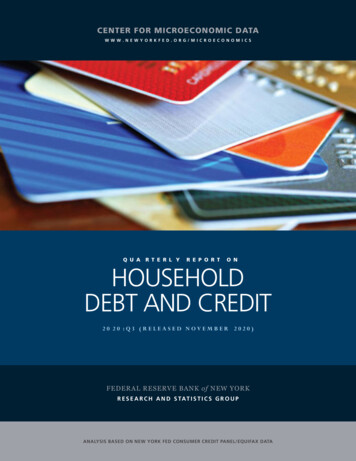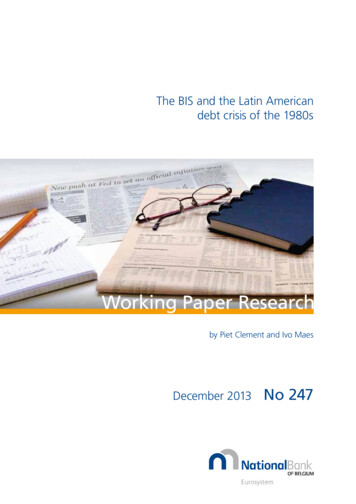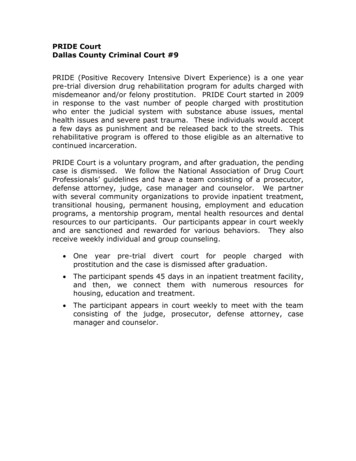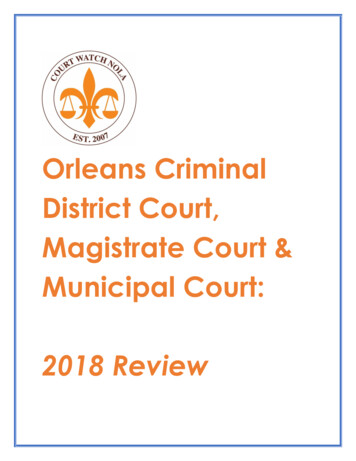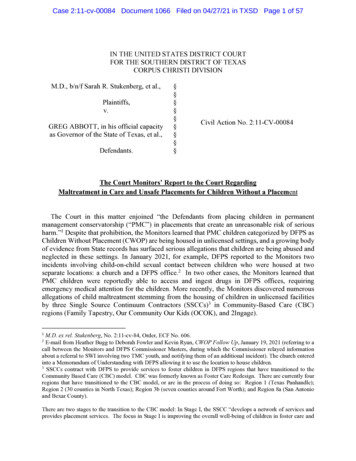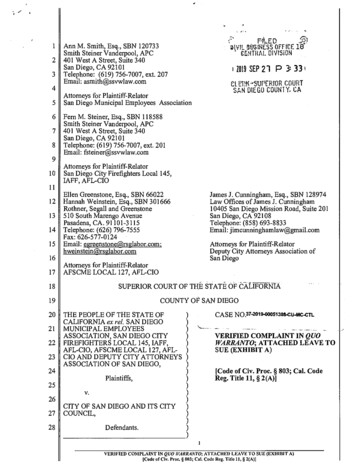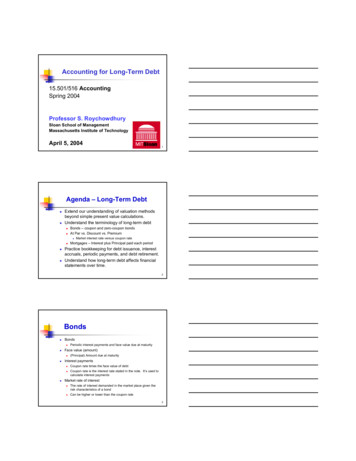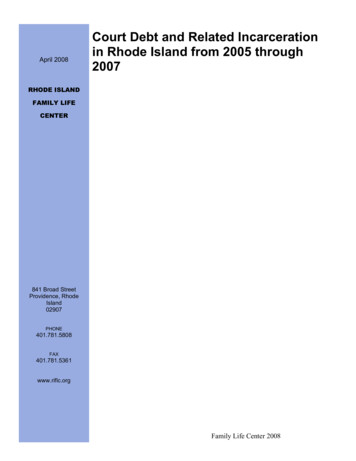
Transcription
April 2008Court Debt and Related Incarcerationin Rhode Island from 2005 through2007RHODE ISLANDFAMILY LIFECENTER841 Broad StreetProvidence, w.riflc.org1Family Life Center 2008
The Family Life Center would like to thank several people for their assistance inthis project, without whom this report would not have been possible, includingDirector A.T. Wall, Erin Boyar, and Terry Foley of the Rhode Island Department ofCorrections. The advice of John Hardiman and Mike DiLauro of the Rhode IslandOffice of the Public Defender was also integral to the ideas in this report.2Family Life Center 2008
Family Life CenterJanuary 2008Report Summary. 4Background Information . 5Protocol for the Assessment and Collection of Fines and Costs . 52006 Legislative Change . 7Other Relevant Rhode Island Statutes . 7Court Costs in Three New England States . 8Relevant Supreme Court Cases . 9Court Debt Collection . 10Methodology: . 10Cost Estimates . 10Interviews . 11Results . 11Overall Results . 11Results of new 150/ day credit . 12Restitution . 13Interviews . 13Characteristics of Individuals Interviewed . 15Collateral Effects of Incarceration. 15Verification and Error . 16Recommendations . 16Introduction . 16Recommendations for Legislation. 17Further Recommendations . 193Family Life Center 2008
Report SummaryIn Rhode Island individuals who owe money to the state because of past criminal convictions arefrequently incarcerated because they fail to appear at ‘Ability to Pay Hearings’. Every year, thousands ofindividuals sit in the Rhode Island jail not for crimes, but because they owe money to the state.Incarceration for court debt is the most common reason to be put in prison in Rhode Island. This reportconcludes that overall, there is a haste to incarcerate individuals for court debt in the state which causesunnecessary, damaging jail time, is an inefficient use of state finances, and disrupts people’s lives. RhodeIsland’s system of court debt is considerably more punitive, more costly to defendants, and lessaccommodating to indigent individuals than other New England states.The debt to the court is either from a fine that is part of a previous sentence or is from court costswhich are assessed in all criminal convictions to generate revenue for the state. Individuals withoutstanding debt are put on payment plans and if they fail to appear for a hearing a warrant is put out fortheir arrest. Once apprehended, they are given another hearing date. They are often put in jail with a bailequal to the total debt until the hearing. This study was undertaken in order to determine the extent towhich incarceration is used as a means to collect debt and to determine why people end up in prison forfines.Department of Corrections and Judiciary data from 2005 through 2007 was analyzed and twentyfive interviews with individuals in the Intake Service Center of the Adult Correctional Institute werecompleted.This study found that incarcerations for court debt comprise 18% of all commitments in the stateof Rhode Island. In both 2005 and 2006, on average there were 24 people each day incarcerated at theACI for court debt. This number has continued to go down since a new law went into affect in late 2006,and averaged 18 in the last six months. In 2007, individuals were incarcerated for an average of threedays and pay bail in only 17% of the incidents. The average amount owed is 826 while a reasonableestimate for the cost of the incarceration is 505. 13% of the incarcerations cost the state more than theamount owed by the individuals. The state spends an estimated 489,919 per year on per diem inmatecosts, prison staff, court, and police costs combined.Although Sixth District Court deals with a much larger quantity of cases than any other court inRhode Island, it generates a disproportionate amount of the incarcerations. 67% of the money spent toincarcerate people for court debt is spent by the Sixth District Court. People incarcerated by Sixth DistrictCourt for court debt spend an average of four days in jail.Most of the individuals interviewed should not have been incarcerated for as much time as theyspent in jail. They either legitimately could not pay their debt or could have been induced to pay throughcheaper methods. In addition, the incarcerations create significant obstacles for individuals attempting toestablish a stable, prosocial life.This report recommends the passage of S2234/H8093, including five central reforms to decreaseunnecessary incarcerations for court debt: 1. Reduce the maximum amount of time people are held in jailawaiting ability to pay hearings to 48 hours. 2. Take ability to pay into account when assessing court finesand costs initially and throughout the payment plans. 3. Employ a variety of collection methods beforeresorting to incarceration. 4. Accept smaller bails from individuals picked up on warrants. 5. Reduce thewarrant fee for people brought in on warrants for failure to appear.4Family Life Center 2008
Background InformationProtocol for the Assessment andCollection of Fines and CostsDebt to the court can be accrued inmultiple ways: child support payments whichmust be made to family court; fines levied as partof a sentence or ticket; restitution levied as partof a sentence, and court costs* which are leviedmuch like user fees to pay for a service.Individuals that owe restitution have theirrestitution debt pooled with debt from fines andcosts. People who owe restitution are givenseparate restitution review hearings. Because ofthe slightly different nature of restitution debtand because it could be identified separately inthe analysis, incarceration for restitution will bediscussed separately.Many criminal charges allow fines to beused in addition to or instead of prison time. Forexample, sentences for possession of marijuanacan include fines of between 200 and 500.Sentences for loitering for indecent purposes caninclude fines between 250 and 1,000.Sentences for driving without a license, firstoffense, can carry a 250- 500 fine. In addition,some crimes allow for restitution as part of asentence. All of these fines are punitive.1In contrast to the punitive nature of courtfines, the court costs system is a way for thecourts to use their authority for the purpose ofcollecting revenue to help fund their operationand other functions related to the criminal justicesystem. Based on Rhode Island state law, peoplewho are found guilty or plead no contest to acrime in Rhode Island state court are assigned afee that is owed to the court.*These ‘user fees’ are generally referred to as ‘court costs’in Rhode Island statute. They are alternately called fees orsurcharges in other states but they will be referred to as‘costs’ throughout this document.1A full list of all of these fines has not been providedbecause of the large number of offense types. They arelocated in Chapters 12, 31 (driving related), and 21-28(controlled substances) of the Rhode Island General Laws.5If the crime is only a misdemeanor, thenunder current law the defendant owes 93.50 foreach charge for which he or she is convicted. Ofthat money, 60 goes to the general revenue(Section 12-18.1-3), 30 goes to a fund that isused to compensate victims of violent crime(Section 12-25-28), and 3.50 goes to thejurisdiction of the police department or stateagency that filed the charge (Section 12-20-6).For a felony charge, which is any criminaloffense that carries a maximum punishment ofmore than one year of imprisonment or a fine ofmore than 1,000, the amount is over 270, andfor felonies which carry a maximum penalty ofover 5 years, it totals over 450. Those who facemultiple charges end up owing several times thisamount, though the court may reduce the amountsomewhat for defendants with four or morecharges (Section 12-18.1-3). See Appendix 1 fora breakdown of court fines.Additionally, many specific types ofcharges carry additional fees, such as a 25 costfor each domestic violence charge (Section 1229-5), which is paid into the state’s generalrevenue. Anyone who is apprehended on awarrant is assessed a 125 fee (Section 12-67.1), 25 of which is paid to the arrestingagency. Most drug charges carry an additionalfee of 400(21-28-4.01-c.3.iii).The state also imposes laboratoryfines which are combined with court costs as partof a defendant’s total debt to the state (Section23-1-3(g),(h)). Most drug related convictionscarry a lab fee of 118 and most serious nondrug related felonies carry an extra lab fee of 100. These fines go into the general fund. As aresult of combined fees individuals with onefelony drug possession charge end up with a totalof at least 788 in court fees.Debt from punitive fines is combinedwith court costs when determining anindividual’s overall debt to the state and it iscollected in the same fashion. In contrast, traffictickets are civil offenses and are assessed andcollected separately in a separate court andcannot independently result in incarceration.The courts’ practice is to allow people togradually repay the amount owed throughregular payments. The courts have claimed thepower to enforce the collection of this debt byFamily Life Center 2008
temporarily incarcerating anyone who can affordthe payment but fails to pay, though in practicethey rarely exercise this authority. Morecommonly, judges use the power of the court toissue court orders that require people who owefines or costs to appear before the court onassigned payment dates. Failure to appear on acourt ordered date results in a bench warrant andis sufficient cause for being held in the state’sprison system. The courts regularly exercise thisauthority.The Sixth District court of Rhode Islandprocesses by far the most cases in Rhode Islandand thus deals with the majority of individualsthat owe court debt to the state. It is protocol inthe Sixth District to alert all those with fines andcosts of the amount they owe and the date oftheir first hearing upon sentencing. Defendantssign a form agreeing to pay the set amount andappear at the set date. Individuals must thenappear at that date and set up a payment plan andset the next hearing date. If the individual is sentto prison, they receive a video conference courthearing one month prior to release in which theywill discuss the date of their first fine hearingand how much they owe. For all later hearingdates, individuals must either appear before ajudge to discuss their ability to pay or pay theclerk the full amount owed. Individuals mustappear in person, even if they can make theirpayment, to sign an agreement to come thefollowing month. Payment in mail and paymentsmade by others are not accepted by the SixthDistrict court.Courtroom 3E, presided over byMagistrate Christine Jabour, is dedicated everymorning between nine and around eleven solelyto ability to pay hearings. These hearings aredesigned to assess the person’s ability to pay,with the court claiming the authority toincarcerate those who fail to pay despite beingable to pay. In practice, the hearing is cursoryand it is extremely rare for people who appear attheir scheduled hearing to be held for failure topay.The hearing often lasts no more than twominutes, and it is focused on getting the personwho is appearing before the judge to agree to afuture payment that he or she will be able to6make. It frequently also involves somediscussion of the person’s employment situation.The magistrate sometimes tells the person to finda job, or a job with longer hours, or a second jobthat will allow them to make payments to thecourt. Occasionally, the hearing will involvemore extensive demands from the judge,especially if the person has arrived late in courtor has not paid the court for a long period oftime. The magistrate might demand that aperson who is not employed search for a job andbring a list of a certain length of places that he orshe has applied for a job to the next hearing if heor she is not able to make a payment by then. Inmost cases, the hearing serves as a way for thecourt to keep in touch with the person who owesthem money and to remind that person of theimportance of paying.If a person fails to make a scheduledpayment and then fails to appear at the scheduledreview hearing, then the judge issues a benchwarrant. Any police officer who has contactwith a person with an outstanding warrant willapprehend him or her. The person will bebrought into the court where he or she owescosts or fines for its next session, which mayinvolve being held in the intake service centerovernight or over the weekend. When the personis taken into court on the bench warrant, theperson’s treatment is at the judge’s discretion.The judge may decide to issue a hold on theperson and set the bail at a level they deemappropriate (Section 12-6-7.1). In practice, theyset it at a number related to the total amountowed in court fines, including all previous costsplus the 125 warrant fee2. Individuals whomiss hearings can ‘surrender’ themselves to thecourt, and the judge will generally waive thewarrant and warrant fee. This practice is2RI General Law 12-6-7.1 recommends setting bail at thetotal amount of fines, however it allows for any bail thatwill ensure the defendant’s appearance at the ability to payhearing. “Any person apprehended on a warrant for failureto appear for a cost review hearing in the superior courtmay be released upon posting with a justice of the peacethe full amount due and owing in court costs as describedin the warrant or bail in an other amount or form that willensure the defendant's appearance in the superior court atan ability to pay hearing, in addition to the one hundredtwenty-five dollars ( 125) warrant assessment feedescribed above.”Family Life Center 2008
relatively rare, possibly because it is not fullyunderstood by defendants. Sometimes judgeswill offer a smaller bail at court, as low as onehalf of the total in fines, although afterwards ifthe person is incarcerated the bail is generally setat the full amount. The bail is always set as cashbail, as opposed to surety bail, which means thatthe individual must pay the full amount to bereleased.In contrast to 6th District Court, inProvidence Superior Court there are attorneys onhand to represent individuals brought in onwarrants, and Ability to Pay Hearings are oftenconducted at someone’s court appearance.While judges in Superior Court still may chooseto hold someone in prison on bail, with those notpaying forced to wait for a bail hearing, this notstandard practice.If an individual cannot pay the necessarybail and the judge chooses to incarcerate theindividual, they are sent to the intake servicecenter. If the bail is paid, then he or she is free togo, and the bail is treated as a payment of thecosts and fines that were owed. Often judgeswill schedule hearings for dates several daysafter incarceration, at which point the court willrelease the individual on personal recognizance.If the individual owes fines to several courts,they will have to wait for hearings at all courtsbefore being released. While many people arereleased after several days, many also spendclose to a week in jail waiting for an ability topay hearing. In much less common cases, theywill spend several weeks in the Intake Centerwithout any communication from the courts,waiting release or a court appearance.Individuals are almost always released after theirability to pay hearings, which consist mainly ofthe judge setting the next payment date for theindividual and reviewing the amount they mustpay. The hearings take place over videoconference and there is no attorney present.2006 Legislative ChangeThe 2006 Legislative Session of theRhode Island Congress passed a bill (House Bill2006-7006, Senate Bill 2006-2326) that amends7Rhode Island General Law 11-25-15 andsubstantially changes how individuals areincarcerated for court fines and costs. Accordingto the previously existing law, individuals wereto be credited five dollars per day that they spendin prison as a result of failure to pay court finesand costs or make the proper appearancesassociated with court fines and costs.3 Theamendment altered this fee from 5 to 125.The intent of the amendment was that if peopleare incarcerated for failure to pay or failure toappear and do not have the ability to make bailthey will receive some compensation for the timespent in prison, which will go to decreasing thenumber of indigent individuals spending time inprison for court fines. The new policy came intopractice in the end of 2006. Perceivable effectsof this new legislation will be discussed in theResults section.Other Relevant Rhode IslandStatutesRhode Island General Law is generallyinterpreted as giving the court the power to remitcosts in criminal cases. Section 12-20-10 states:311-25-15. Imprisonment for failure to pay finesor costs or give recognizance. – Every person who hasbeen or shall be committed or detained in the adultcorrectional institutions for the nonpayment of his or herfine or costs, or both, or for failure to give therecognizance in the amount required of him or her to keepthe peace, shall be detained in the
This study found that incarcerations for court debt comprise 18% of all commitments in the state of Rhode Island. In both 2005 and 2006, on average there were 24 people each day incarcerated at the ACI for court debt. This number has continued to go down since a new law went into aff
